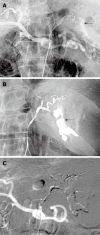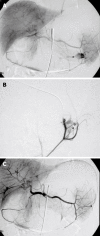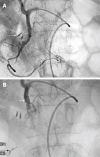Role of transcatheter arterial embolization for massive bleeding from gastroduodenal ulcers
- PMID: 20014452
- PMCID: PMC2795175
- DOI: 10.3748/wjg.15.5889
Role of transcatheter arterial embolization for massive bleeding from gastroduodenal ulcers
Abstract
Intractable bleeding from gastric and duodenal ulcers is associated with significant morbidity and mortality. Aggressive treatment with early endoscopic hemostasis is essential for a favourable outcome. In as many as 12%-17% of patients, endoscopy is either not available or unsuccessful. Endovascular therapy with selective catheterization of the culprit vessel and injection of embolic material has emerged as an alternative to emergent operative intervention in high-risk patients. There has not been a systematic literature review to assess the role for embolotherapy in the treatment of acute upper gastrointestinal bleeding from gastroduodenal ulcers after failed endoscopic hemostasis. Here, we present an overview of indications, techniques, and clinical outcomes after endovascular embolization of acute peptic-ulcer bleeding. Topics of particular relevance to technical and clinical success are also discussed. Our review shows that transcatheter arterial embolization is a safe alternative to surgery for massive gastroduodenal bleeding that is refractory to endoscopic treatment, can be performed with high technical and clinical success rates, and should be considered the salvage treatment of choice in patients at high surgical risk.
Keywords: Angiography; Embolization; Endoscopy; Massive bleeding; Peptic ulcer.
Figures




References
-
- Laine L, Peterson WL. Bleeding peptic ulcer. N Engl J Med. 1994;331:717–727. - PubMed
-
- Encarnacion CE, Kadir S, Beam CA, Payne CS. Gastrointestinal bleeding: treatment with gastrointestinal arterial embolization. Radiology. 1992;183:505–508. - PubMed
-
- Consensus conference: Therapeutic endoscopy and bleeding ulcers. JAMA. 1989;262:1369–1372. - PubMed
-
- Goldman ML, LAND WC, Bradley EL, Anderson RT. Transcatheter therapeutic embolization in the management of massive upper gastrointestinal bleeding. Radiology. 1976;120:513–521. - PubMed
Publication types
MeSH terms
LinkOut - more resources
Full Text Sources
Medical

